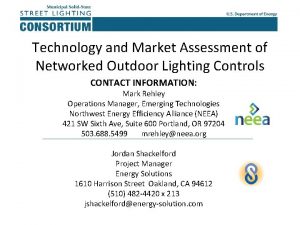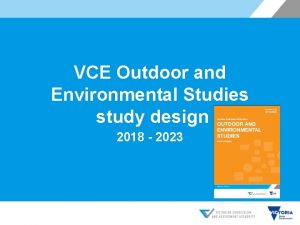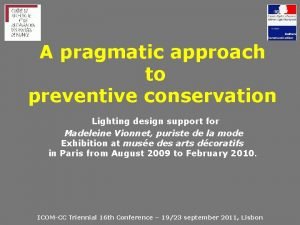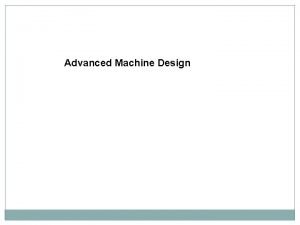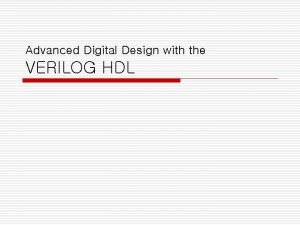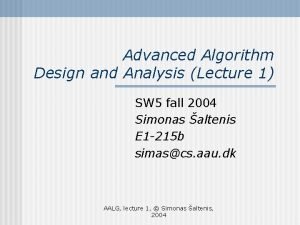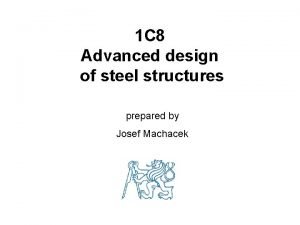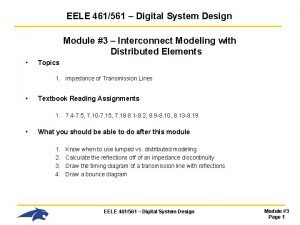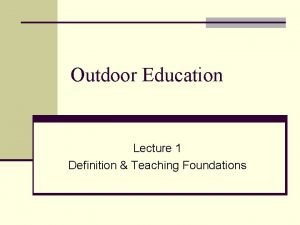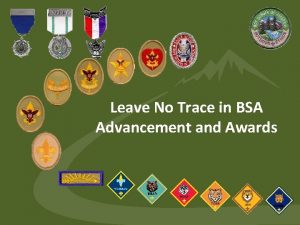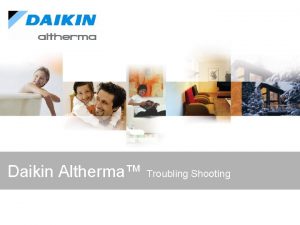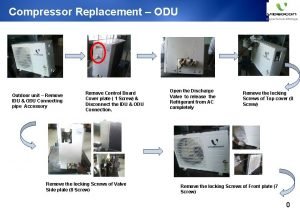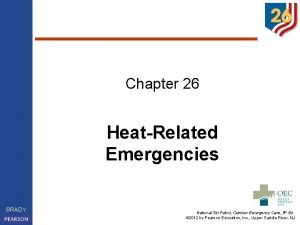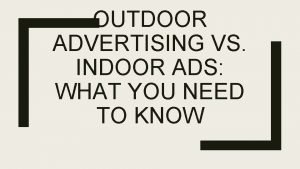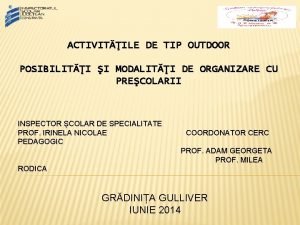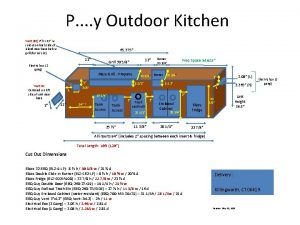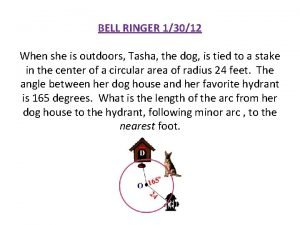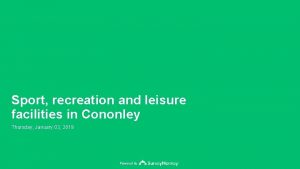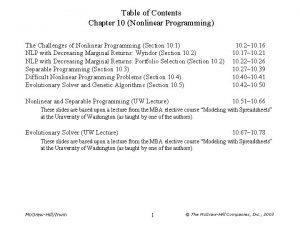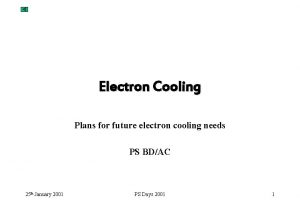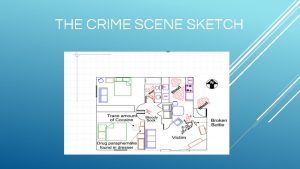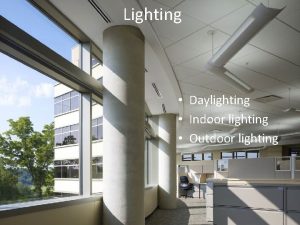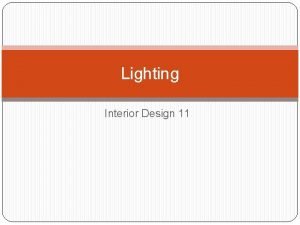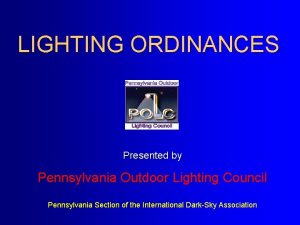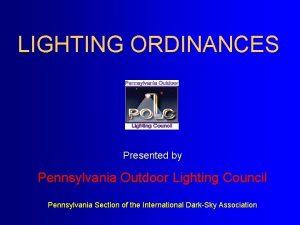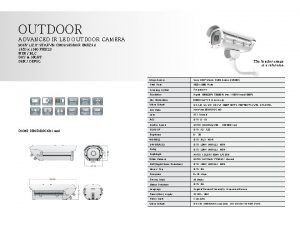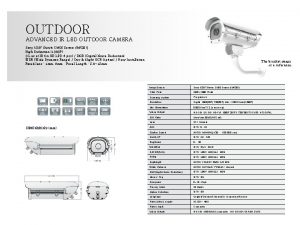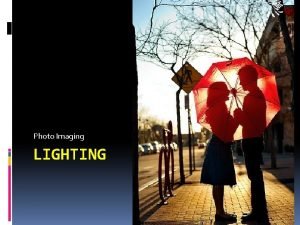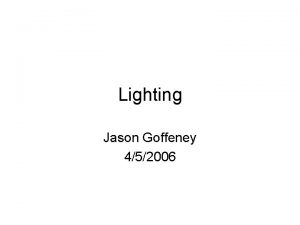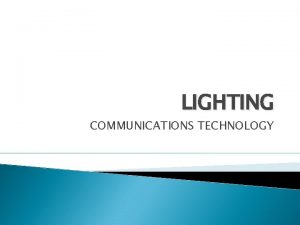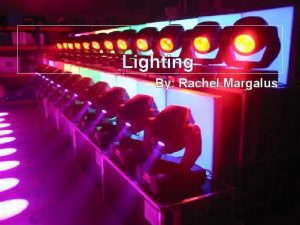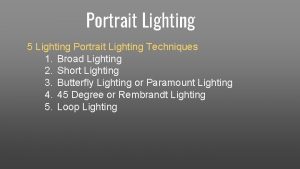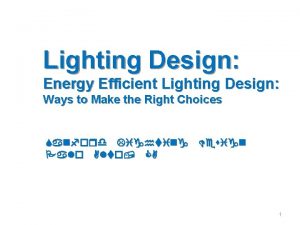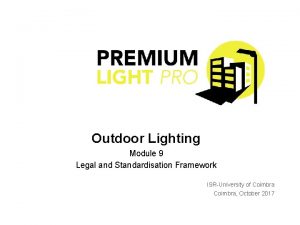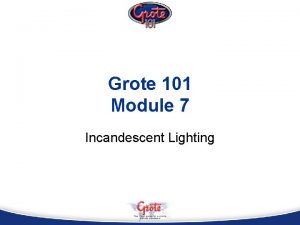Outdoor Lighting Module 9 Lighting Design Advanced ISRUniversity
































































- Slides: 64

Outdoor Lighting Module 9 Lighting Design – Advanced ISR-University of Coimbra, October 2017

Outdoor Lighting - Module 9 Lighting Design – Advanced Objectives: - Identify different road lighting classes and their different requirements, establishing suitable design criteria; - be able to design a lighting system for an example situation; - be able to evaluate an existing outdoor lighting installation for effectiveness, safety, and efficiency, and develop recommendations for improvements where needed. 2

Outdoor Lighting - Module 8 Lighting Design – Advanced Topics: a) b) c) d) e) f) Importance of street and road lighting Photometric Diagrams Utilization factor Lighting classes and establishing photometric requirements Street lighting parameters Project example 3

Importance of street and road lighting • Street lighting is an essential public service that provides a safer environment at nighttime for drivers as well as for pedestrians: - Eliminates night time accidents; - Enhances the sense of personal security and helps police protection and safety population; - Ensures better traffic flow; - Promotes business activities, transport and travelling at night; - Beautifies parks, built environment, monuments and historical places. • Provide the driver with the necessary visibility to distinguish obstacles and the road layout with enough time to maneuver in order to guarantee security, as well as providing the driver with visual comfort. 4

Photometric Diagrams • The most commonly used coordinate system for street lighting luminaires, in the representation of photometric information, is the system (C - �� ); • The vector “I” represents the value of the luminous intensity, while C and “�� ” signal their direction; • “C” indicates the vertical plane where the vectors are located and �� measures the slope relative to the vertical photometric axis of the luminaire. 5

Photometric Diagrams • “C” Angles: • • Plans between 0º and 180º are located on the side of the road; Transverse plane (C = 90° and 270°). This plane would be perpendicular to the axis of the road for a road lighting luminaire; Longitudinal plane (C = 0° and 180°). This plane would be parallel to the axis of the road for a road lighting luminaire; The plane in which maximum intensity is found. This plane is generally called main vertical plane. • “�� ” Angles: • • • �� = 0º - Indicates the vector of luminous intensity pointing vertically from the luminaire to the surface; �� = 90º - Corresponds to an horizontal vector to the luminaire; �� = 180º - Indicates that the light intensity vector is pointing upwards the luminaire, vertically. 6

Photometric Diagrams Polar distribution curves • If we plot in a transverse plane, a curve along the edges of all the vectors of the luminous intensity “I” (cd / m 2), which originates at the lamp, we obtain the light distribution curve of that source; • Thus, the polar diagram is the representation of the luminous intensity at all angles (�� ), on which it is directed, in a vertical plane (C); • When the light distribution curve has symmetry with respect to the lamp axis, only plane in the diagram is required. • If there is no symmetry around the axis of the light source, the polar diagram will have to present the distribution curves in the vertical planes necessary for its characterization, being obligatory to include the plane where the light intensity is maximum. 7

Photometric Diagrams Polar distribution curves • Polar distribution curves are defined in cd by 1 000 lumens of flux emitted by each lamp and it is represented by cd/1 000 lm or cd/klm. Polar diagram (with symmetry) Polar diagram (with asymmetry) Source: Indalux 8

Photometric Diagrams Isocandela diagrams • Although the polar diagrams are a very useful and practical tool, they present only information on what happens in the vertical planes (C), not showing what is happening on other points; • To avoid this inconvenience, and to combine a flat representation with the information on the luminous intensity in any direction, the isocandela diagram was created; • It simulates the luminaire in the center of a sphere, where on its outer surface the points of the same intensity (isocandelas curves) are joined in a row; • Usually the luminaires have at least a plane of symmetry, so only a semi-sphere is normally considered. 9

Photometric Diagrams Isocandela diagrams • Isocandela diagram in azimuthal projection. Source: Indalux 10

Photometric Diagrams Isolux or isoilluminance diagrams • If we project the values of the illuminance emitted on a surface, by a light source, on the same plane and join by a line those of identical value, we will have the so called “isolux curve”; • The various isolux curves form the isolux diagram, where “h” is the height of the luminaire; • Values for each isolux line are given in Emax percentages, the highest being 100%. 11

Photometric Diagrams Isolux or isoilluminance diagrams • Isolux diagram on the surface to be illuminated. 12

Utilization factor • In street lighting, the utilization factor is defined as the fraction of the luminous flux coming from a luminaire which, in fact, reaches the street/road; • Utilization factor curves found on the photometric information sheets offer a simple method to calculate average illumination, which may be determined for a certain transverse section of the road: • Utilization factor curves for a luminaire are understood as a function of transverse distances, measured in terms of “h” (mounting height) on the street/road surface, from the center of the luminaire up to each of the two curves. 13

Utilization factor • The easiest and quickest way to calculate average illuminance of a straight road of infinite length is by applying the utilization factor curves: Utilization factor as a function of “h” where: • η = utilization factor • Φ = lamp luminous flux • n = number of lamps per luminaire • w = width of the road • s = interdistance between luminaires Source: Indalux 14

Lighting classes - Outdoor lighting installations provide road lighting for the benefit of drivers of motorized vehicles on one or more traffic lane and in some cases on side areas; - Outdoor lighting includes also monuments and the road side areas with pedestrian side walks, cycle lanes, emergency lanes or just plain areas next to the traffic lane; - The geometry of road areas may sometimes be simple (i. e. single traffic lane) or in other cases, it may be necessary to provide into account a curve of a road, or a road area of a complex shape. 15

Lighting classes Establishment of photometric requirements - There are simple and standardized solutions on how to choose the lighting parameters of a public lighting installation, taking into account the characteristics of the area to be illuminated, namely • road function and geometry; • allowed speed; • volume of traffic. - The parameters shall be determined by the luminance or illuminance criteria; - The medium and high speed zones are defined by the luminance criteria; - Conflict zones and pedestrian zones can be defined by both the illuminance and luminance criteria. 16

Lighting classes Establishment of photometric requirements - When the complexity of the layout and the diversity of surfaces are low, which normally occurs outside urban areas, the criterion to be used is the luminance. Thus, the areas to be illuminated must have at least the same level of illumination of the roads that give them access. The ideal is that the lighting class has an index below the lighting class of the adjacent road; - In areas where the complexity of the layout and the diversity of surfaces do not allow a reliable calculation of luminance, the criterion of illuminance shall be used. Lighting class of a conflict zone (roundabound) by the luminance criterion 17

Lighting classes Lighting level requirements - Lighting requirements of a certain public area depend largely on their specific lighting class category; - A lighting class is defined by a set of photometric requirements that point to the visibility needed for users of the various types of streets, roads and other public areas; - Since the needs of pedestrians greatly differ from drivers in many aspects, such as speed of movement, proximity of objects, surface pattern, facial recognition, etc. , different parameters are used (luminance , Illuminance, etc. ) to characterize the minimum conditions of illumination of a certain class. 18

Lighting classes - The most widely accepted definitions in terms of lighting classes, performance criteria and measurement methods can be found in the EN 13201 standard series: • EN 13201 -1 : 2004 - Selection of lighting classes • EN 13201 -2 : 2016 - Performance requirements • EN 13201 -3 : 2015 - Calculation of performance • EN 13201 -4 : 2015 - Methods of measuring lighting performance • EN 13201 -5 : 2015 - Energy performance indicators - “CIE 115 -2010 - Recommendations for the lighting of roads for motor and pedestrian traffic” has recommendations on quality criteria, lighting classes, motor traffic requirements, flow regulation, etc. , for all road categories and areas to be illuminated. - In order to broadly harmonize the requirements, the lighting classes were defined on the basis of the national standards of the member states and the CIE 115 -2010 standard. 19

Lighting classes EN 13201 - EN 13201 -1 uses a selection procedure for determining lighting classes; - EN 13201 -2 provides specifications for the different lighting classes which are defined by a set of photometric requirements depending on the needs and requirements of the specific road users and road types. Introduces a number of additional metrics which are used to define minimum or maximum criteria for each subclass; - EN 13201 -3 describes the mathematical methods and procedures which should be used to calculate the lighting performance characteristics defined in EN 13201 -2. 20

Lighting classes EN 13201 21

Lighting classes - The EN 13201 series of standards introduced lighting classes in order to facilitate and develop public lighting services in the European Union, aiming at standardization and harmonization of requirements; - Each class is associated with several indexes that define their subclasses. In this way, we can better characterize the situation and define, in an optimized way, the values of its lighting parameters; - After identifying the class and subclass for a certain area to be illuminated, the EN 13201 -2 provides a series of tables with the lighting parameters to introduce on the simulation software; - The lighting requirements may also be subject to national standardization or regulation. 22

Lighting classes Existing lighting classes according to EN 13201 High Velocity M C Applies to motor vehicles on high and medium speed roads Zone of conflict: when the tracks of the vehicles intercept and end in areas frequented by pedestrians, cyclists, etc. Examples are roundabouts, intersections, connecting roads with reduced width and number of reduced lanes and shopping center areas. P Low Peculiar to exclusively pedestrian areas Defined by horizontal illuminance parameters ES For pedestrian zones where the crime risk is higher Defined by semicylindrical illuminance parameters EV For areas where facial and vertical surface recognition are essential Defined by vertical illuminance parameters 23

Lighting classes Subclass - The selection criteria for each subclass (as designated by their digit) are based on the geometry of the road, its traffic usage, and its environment; - Geometric criteria include: • • • Separation of lanes with different traffic directions (yes/no) Type of intersections (crossroads/motorway junction) Distance between motorway junctions or bridges (more or less than 3 km) Density of intersections (more or less than 3 intersections/km) Conflict zone (yes/no - defined as a road locations where streams of motorized traffic meet or which other traffic participants such as pedestrians or cyclists use) Engineering measures for traffic calming in place (yes/no) 24

Lighting classes Subclass - Traffic usage criteria include: - Traffic density of motorized vehicles (number of vehicles per day) - Traffic density of cyclists (normal/high) - Traffic density of pedestrians (normal/high) - Difficulty of navigating traffic (normal/higher than normal – defined as the difficulty in picking speed or position on the road based the visual information available) - Parking vehicles (permitted/not permitted) - Visual recognition (necessary/not necessary) - Risk of crime (normal/higher than normal – based on a comparison between the likelihood of crime at the location with the likelihood of crime in the wider region). 25

Lighting classes Subclass - Environmental conditions include: - Complexity of visual stimuli within the field of vision (normal/high) - Luminance of the environment (rural environment/urban environment/city centre) - Prevalent weather (dry/wet – no longer applicable for the newer lighting class designations) - Certain parameters (in particular traffic density and luminance of the environment) may change from season to season, or during different hours of the night. Thus road sections may be shifted to a different road class. 26

Lighting classes How to determine the subclass number Define which is the lighting class (M, C, or P) of the zone to be illuminated Is it a conflict zone? C Class? Is it in a urban area? NO Luminance criterion Class index equal to or less than adjacent road YES Use illuminance criterion NO Assign, appropriately, a weight factor to each process specified in the next tables Add up all of the selected factors, getting a TOTAL value: (Subclass number = 6 -TOTAL) 27

Lighting classes How to determine the subclass number Weight factors that characterize the public place to illuminate Parameter Velocity Traffic volume Options M C P Very high High Moderate Slow Very slow Very high High Moderate Low Very low 1 0, 5 0 - 3 2 1 0 - 1 0, 5 0 -0, 5 -1 28

Lighting classes How to determine the subclass number Weight factors that characterize the public place to illuminate Parameter Traffic composition Separation of tracks Options High percentage of nonmotorized vehicles Mixed Only motorized Pedestrians, cyclists and motorized traffic Pedestrians and cyclists Pedestrians or cyclists No Yes M C P 2 - 1 0 - - 2 - 1 0 1 0 29

Lighting classes How to determine the subclass number Weight factors that characterize the public place to illuminate Parameter Density crossings Parked vehicles Ambient Luminance Traffic control Options M C High 1 - Moderate Present Not present High Moderate Low Weak Good 0 - 0, 5 0 - P 0, 5 0 1 0 -1 0, 5 0 30

Lighting classes How to determine the subclass number (Values used in Portugal) Velocity (km/h): Very high | x>70 High | 50 < x ≤ 70 Moderate | 20 < x ≤ 50 Low | x ≤ 20 Very low | only pedestrians Traffic volume (vehicles (x) Pedestrians/Cyclists (y) per day): Very high | y ≥ 2. 000 Very high| x ≥ 40. 000 High | 1. 000 ≤ y < 2. 000 High | 25. 000 ≤ x < 40. 000 Moderate | 15. 000 ≤ x < 25. 000 Moderate | 500 ≤ y < 1. 000 Low | 100 ≤ y < 500 Low | 4. 000 ≤ x < 15. 000 Very low| y < 100 Very low| x < 4. 000 31

Lighting classes How to determine the subclass number Ambient Luminance: High: Urban areas with high levels of roadway and decorative lighting. May contain brightly lighted commercial advertising signs, building facades and/or shop windows. Moderate: intermediate areas with some roadway lighting, lighted road signs and/or commercial advertising signs. Low: Rural areas, without or with limited roadway and/or intersection lighting. 32

Lighting classes How to determine the subclass number Intersection density: High | crossings (intersection of two or more roads) Moderate | three-way intersetions Traffic Control: Weak | without stop light Good | with stop light 33

Lighting classes Photometric requirements for high and medium speed classes Road surface Lighting class Dry Wet TI (%) SR Laverage (cd/m 2) Uo Ul Uo M 1 2 0, 4 0, 7 0, 15 10 0, 5 M 2 1, 5 0, 4 0, 7 0, 15 10 0, 5 M 3 1 0, 4 0, 6 0, 15 15 0, 5 M 4 0, 75 0, 4 0, 6 0, 15 15 0, 5 M 5 0, 35 0, 4 0, 15 15 0, 5 M 6 0, 35 0, 4 0, 15 20 0, 5 34

Lighting classes Photometric requirements for conflict zone classes TI (%) Lighting class Eaverage (lux) Uo(E) C 0 C 1 C 2 C 3 C 4 C 5 50 30 20 15 10 7, 5 0, 4 0, 4 High and moderate velocities 10 10 10 15 15 15 Low and very low velocities 15 15 15 20 20 25 35

Lighting classes Photometric requirements for low-speed classes (pedestrian areas) If additional requirements for facial recognitions are needed Evertical, minimal Esemi-cilyndrique, minimal (lux) Lighting class Emédia (lux) Emínima (lux) P 1 15 3 P 2 10 2 3 2 P 3 7, 5 1, 5 2, 5 1, 5 P 4 5 1 1, 5 1 P 5 3 0, 6 1 0, 6 P 6 2 0, 4 0, 6 0, 4 36

Street lighting parameters • Night time driving implies a mesopic or twilight vision comprised in the interval between 0, 01 and 3 or 4 cd/m 2; • It’s characterized by a reduction in visual sharpness and a diminution in contrast differential sensitivity; • A high luminance contrast threshold is necessary for obstacle visibility; • Vehicle headlights only illuminate a limited area ahead of them, while public lighting provides light to the road and its surroundings, opening the field of vision to the driver. 37

Street lighting parameters • Differential sensitivity to contrast for any same driver is more than three times higher in a road provided with lighting (2 cd/m 2), when compared with that provided by a vehicle traffic beam (0. 2 to 0. 3 cd/m 2); • Visual sharpness during night time driving on a road provided with lighting, becomes two and a half times higher than for the same driver using only the vehicle dipped headlights; 38

Street lighting parameters • Lighting metrics: flux, intensity, illuminance and luminance (Module 8); • Color temperature and rendering index (Module 8); • Flicker / Glare and Lumen depreciation (Module 8); • Uniformity; • Surrounding Ratio; • Maintenance Factor; 39

Street lighting parameters Uniformity • One of the main objectives in street lighting is to provide good street and road surface illumination so that obstacles can be easily identifiable. Thus, it is fundamental that there are no black areas between the illuminated areas, that is, that there is uniformity in illumination; • The general uniformity (U 0) is calculated as the ratio between the lowest luminance value (Lmin) (existing at any point in the calculation field) and the mean luminance (Lmed): 40

Street lighting parameters Uniformity • The longitudinal uniformity (Ul) is calculated by the quotient between the lowest value (Lmin) and the highest value (Lmax) of the luminance, in the longitudinal direction, along the center of each lane: minimal Illuminance average máximal Longitudinal direction 41

Street lighting parameters Uniformity • The number of points in the longitudinal direction and the space between them must be the same as that used in the calculation of mean luminance. In addition, the position of the observer must be in the line of the calculation points; • The mean uniformity (Um) may also be defined as the ratio of the minimum illuminance value (Emin) to the mean illuminance value (Emed) of a lighting installation: 42

Street lighting parameters Uniformity • In addition to adequate and uniform street and road lighting, the visibility of the upper part of higher objects on the road, or of objects on the sides of the lanes (particularly in curved sections), can not be overlooked; • These are only seen if there is good illumination in the surroundings of the road; • The driver will be able to make adjustments of speed and trajectory, in due time; • Thus, it is the function of the “Surrounding Ratio” (SR) to ensure that the light flux directed to the periphery of the roads is sufficient for the effect. 43

Street lighting parameters Surrounding Ratio Longitudinal exterior lane (1) Longitudinal interior lane (2) Road side boundaries Longitudinal interior lane (3) Longitudinal exterior lane (4) 44

Street lighting parameters Uniformity • Taking into account the characteristics of the roads and its surroundings, the width of each of these longitudinal lanes, for the calculation of the surrounding ratio, must be the same, and equal to the minimum value of the following three hypotheses: Width equal to 5 meters Width equal to half the width of the road. Width equal to that of the outside of the roadway that is not obstructed. 45

Street lighting parameters Maintenance Factor • A maintenance factor (MF) is applied to a lighting design to take into account the reduction in the output of the luminaires used within any lighting installation and ensure the correct level of light is delivered at the ‘lamp/luminaire end of life’; • The MF calculation takes into account lumen depreciation and the impact of the environment will have on the installation; • The maintenance factor (MF) of an installation is the ratio of the illuminance at a given moment (E (t)), with the initial illuminance (E 0); • MF can also be obtained by the product between the Lamp Lumen Maintenance Factor (LLMF), Luminaire Maintenance Factor (LMF), Room Surface Maintenance Factor (RSMF) and Lamp Survival Factor (LSF): • MF = LLMF x RSMF x LSF 46

Street lighting parameters Maintenance Factor • Lamp Lumen Maintenance Factor (LLMF) • Ratio between the luminous flux of the lamp at a given moment of its life (ø (t)) and the initial luminous flux (ø 0); • Describes the aging of the lamp or the reduction of light intensity over time; • Manufacturers usually offer comprehensive tables about their lamps luminous flux behavior. • Luminaire Maintenance Factor (LMF) • Ratio of the luminaires luminous flux before and after cleaning; • It depends on the luminaire construction and design (open housing or closed one) as well as on environmental conditions (dirty or clean); • The higher the luminaires protection degree from dust, and the cleaner the area, the higher the maintenance factor; • Consider the accessibility of the luminaires when setting up the maintenance plan. The more difficult to reach, the higher the maintenance costs will be. 47

Street lighting parameters Maintenance Factor • Room Surface Maintenance Factor (RSMF) • Ratio of the room (or tunnel) surfaces reflectance before and after cleaning; • It is the reduction of the lighting level according to soiling of the room; • It depends highly on the conditions in a room, if the room is very clean, dirty or very dirty. The more dirty the room, the lower the maintenance factor. • Lamp Survival Factor (LSF) • Depends on the service lifetime of a lamp. Some lamp lifetimes are reduced by frequent switching; • Lamp manufacturers provide tables indicating the lamp survival factor; • If a lamp is not working anymore, the decision for immediate replacement or group replacement needs to be taken; • If the lamp is replaced immediately (mostly in areas where the luminaire is easily reachable) the LSF can be set 1. LSF 1 is saying that there will be no loss of light because of lamp failure. 48

Street lighting parameters Maintenance Factor • Lamp Lumen Maintenance Factor (LLMF) - Example Source: Whitecroft Lighting 49

Street lighting parameters Maintenance Factor • Example MF, standard L 70@50, 000 h rated luminaire: LLMF L 70 = 0, 7 LSF = 1 LMF clean environment = 0, 94 RSMF clean environment = 0, 95 MF = 0, 7 x 1 x 0, 94 x 0, 95 = 0, 63 MF, standard L 90@50, 000 h rated luminaire: LLMF L 90 = 0, 9 LSF = 1 LMF clean environment = 0, 94 RSMF clean environment = 0, 95 MF = 0, 9 x 1 x 0, 94 x 0, 95 = 0, 80 30 luminaires needed, average 315 Lux Only 25 luminaires needed, average 331 Lux 15 m 50

Project example Roundabout 1 Roundabout 2 Road 1 Road 2 Road 3 Pedestrian 1 Source: EDP, Portuguese Utility Pedestrian 2 51

Project example • The first step is to define, together with the entities responsible for street lighting, the classes to apply to each of the locations; • The determination of the lighting classes throughout the night period, the color temperature and the CRI should also be defined in together with the same entities; • For this example, the following classes were considered: • M (fast or moderate speed); • C (conflict area) or P (public space mostly pedestrian). 52

Project example • The following table indicates the classification assigned to each identified area to be illuminated: Location Comments Lighting class Road 1 Rapid approach road M Road 2 Residential road M Road 3 Residential road M Roundabout 1 Roundabout connecting a residential road to a highway C Roundabout 2 Roundabout between residential roads C Pedestrian 1 Garden P Pedestrian 2 Bicycle area with great flow of people P 53

Project example Velocity Option Weight factor High 0, 5 Traffic composition Option Weight factor Motorized only 0 Density crossings Option Weight factor Moderate 0 Environment luminance Option Weight factor Low -1 Traffic volume Option Weight factor Moderate 0 Lane separation Option Weight factor No 1 Parked vehicles Option Weight factor Not present 0 Traffic control Option Weight factor Weak 0, 5 54

Project example • Road 2: Velocity Option Weight factor Moderate or reduced 0 Traffic composition Option Weight factor Mixed 1 Density crossings Option Weight factor High 1 Environment luminance Option Weight factor Low -1 Traffic volume Option Weight factor High 0, 5 Lane separation Option Weight factor Yes 0 Parked vehicles Option Weight factor Present 1 Traffic control Option Weight factor Weak 0, 5 • “Road 2” is a M 3. 55

Project example • Road 3: Velocity Option Moderate or reduced Weight factor 0 Traffic volume Option Weight factor Moderate 0 Traffic composition Lane separation Option Weight factor Mixed 1 No 1 Density crossings Option Weight factor High 1 Environment luminance Option Weight factor Low -1 Parked vehicles Option Weight factor Present 1 Traffic control Option Weight factor Weak 0, 5 • “Road 3” is a M 3. 56

Project example • For the characterization of the conflict areas Round 1 and Round 2, and since we are in a zone outside the urban perimeter, the criterion of luminance is used; • This determines that the index of this zone is at least equal to that of the adjacent road; Conflit area Road adjacent lower index Roundabout class Roundabout 1 R 2 / R 3 (M 3) M 2 Roundabout 2 R 2 /R 3 (M 3) M 2 57

Project example • Finally we will characterize, the existing pedestrian zones; • Pedestrian 1: Velocity Option Low Weight factor 1 Traffic composition Option Weight factor Pedestrians, cyclists 2 and motorized traffic Environment luminance Option Weight factor High 1 Traffic volume Option Weight factor Low -0, 5 Parked vehicles Option Weight factor Present 0, 5 Facial recognition Option Weight factor No additional requirements are required • “Pedestrian 1” is a P 2. 58

Project example • Pedestrian 2: Velocity Option Low Weight factor 1 Traffic composition Option Weight factor Pedestrians, cyclists 2 and motorized traffic Environment luminance Option Weight factor Moderate 0 Traffic volume Option Weight factor Moderate 0 Parked vehicles Option Weight factor Present 0, 5 Facial recognition Option Weight factor No additional requirements are required • “Pedestrian 2” is a P 2. 59

Project example • After characterizing the various zones and identifying the index of its lighting class, the values of the lighting parameters that must be fulfilled in the project are now defined by the tables already showed; Location Class Luminance Uniformity SR TI Road 1 M 5 0, 5 cd/m 2 0, 4 0, 5 15 % Road 2 e 3 M 3 1 cd/m 2 0, 7 0, 5 Roundabout 1 e 2 M 2 1, 5 cd/m 2 0, 7 SR 15 % 10 % Location Class Pedestrian 1 e 2 P 2 ILuminanceaverage 10 lux ILuminanceminimal 2 lux TI 25 % 60

Project example • The designer now has to choose the column, luminaire and respective light source, distribution and distance between columns in order to obtain a compromise between the calculated average values and the energy efficiency of the project; • For this purpose, computational simulation tools (i. e. Dialux) can be used to carry out a representative lighting study; • The simulation software offers a variety of tools that by a simple entering a custom change, the lighting designer can verify if the project is according to the regulations or not. 61

Partner of Premium Light Pro Funded by EU Comission under Horizon 2020 EU Partners 62

Partners of Premium Light Pro Name Bernd Schäppi Michal Stasa Country Austria Organisation Austrian Energy Agency email bernd. schaeppi@energyagency. at Czech Republik www. energyagency. at SEVEn michal. stasa@svn. cz Caspar Kofod Anibal T. De Almeida Denmark Portugal Stewart Muir United Kingdom www. svn. cz Energy. Piano Institute for Systems and Robotics, University of Coimbra Energy Saving Trust Germany www. energysavingtrust. org. uk/ CO 2 ONLINE Boris Demrovski Andrea Roscetti Italy Aniol Esquerra Spain Łukasz Rajek Poland www. co 2 online. de Politecnico Milano http: //www. energia. polimi. it/index. php Ecoserveis ck@energypiano. dk adealmeida@isr. uc. pt Stewart. Muir@est. org. uk Boris. Demrovski@CO 2 Online. de andrea. roscetti@polimi. it aniol@ecoserveis. net www. ecoserveis. net FEWE l. rajek@fewe. pl The Polish Foundation for Energy Efficiency www. fewe. pl 63

Thank you very much! Contact: ************************* 64
 Airinet
Airinet Inverter error codes
Inverter error codes New vce english study design 2023
New vce english study design 2023 Outdoor wireless mesh network design
Outdoor wireless mesh network design C device module module 1
C device module module 1 Bluegrassairport.com
Bluegrassairport.com Conservation lighting design
Conservation lighting design Emergency lighting design nz
Emergency lighting design nz Unit 18 database design
Unit 18 database design Advanced machine engineering
Advanced machine engineering Advanced digital design with the verilog hdl
Advanced digital design with the verilog hdl Advanced compiler design and implementation
Advanced compiler design and implementation Cse 598 advanced software analysis and design
Cse 598 advanced software analysis and design Advanced database design
Advanced database design Cadmim
Cadmim Advanced algorithm design
Advanced algorithm design Advanced design of steel structures notes
Advanced design of steel structures notes Training module template
Training module template Module 7 research design and ethics in psychology
Module 7 research design and ethics in psychology Line of reflection
Line of reflection Lancashire outdoor education
Lancashire outdoor education Cub scout oath and law
Cub scout oath and law Outdoor activities vocabulary
Outdoor activities vocabulary Outdoor code
Outdoor code Plas gwynant outdoor education centre
Plas gwynant outdoor education centre Tread lightly meaning bsa
Tread lightly meaning bsa Definition of outdoor education
Definition of outdoor education Cub scout leave no trace principles
Cub scout leave no trace principles Outdoor sports chart
Outdoor sports chart Types of games indoor and outdoor
Types of games indoor and outdoor Frank chapman centre
Frank chapman centre Daikin altherma problems
Daikin altherma problems Idu odu
Idu odu Outdoor emergency care 6th edition
Outdoor emergency care 6th edition Burwardsley school trip
Burwardsley school trip Cuffley adventure days
Cuffley adventure days Purdue climbing club
Purdue climbing club Indoor and outdoor advertising
Indoor and outdoor advertising High ashurst outdoor education centre
High ashurst outdoor education centre Frank chapman outdoor education centre
Frank chapman outdoor education centre Leave no trace boy scouts
Leave no trace boy scouts Beneficiile educatiei outdoor
Beneficiile educatiei outdoor Trends in outdoor recreation
Trends in outdoor recreation Outdoor recreation adoption model
Outdoor recreation adoption model Outdoor kitchen vent
Outdoor kitchen vent Outdoor ed mcps
Outdoor ed mcps When she is outdoor tasha the dog
When she is outdoor tasha the dog Wish outdoor
Wish outdoor Robin wood activity centre
Robin wood activity centre Outdoor voltage regulator
Outdoor voltage regulator Borwick hall outdoor education centre
Borwick hall outdoor education centre Lorado taft outdoor education
Lorado taft outdoor education Wireless lan applications
Wireless lan applications Outdoor recreation resources review commission
Outdoor recreation resources review commission The outdoor furniture corporation manufactures two products
The outdoor furniture corporation manufactures two products Outdoor adventurous activities
Outdoor adventurous activities Outdoor adventurous activities
Outdoor adventurous activities Future of outdoor cooling
Future of outdoor cooling Outdoor stem journey
Outdoor stem journey Burnhamthorpe outdoor rink
Burnhamthorpe outdoor rink Crime
Crime Porthpean activity centre
Porthpean activity centre Outdoor software
Outdoor software Knowsley outdoor education centre
Knowsley outdoor education centre Alat permainan edukatif outdoor
Alat permainan edukatif outdoor
